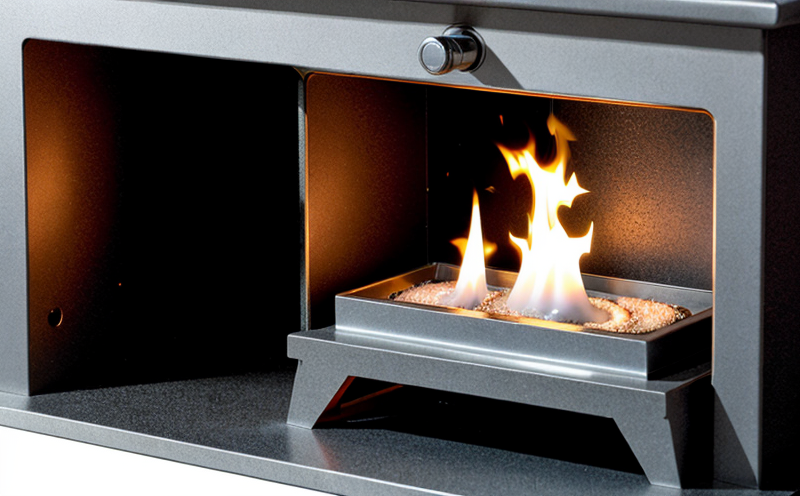Ignitability Testing under Radiant Heat Exposure
The ignitability testing under radiant heat exposure is a critical process used to evaluate the ability of materials and products to ignite or continue burning when exposed to radiant heat. This testing method is particularly important in sectors like fire safety, building construction, and material science where compliance with regulations and standards is paramount.
The test simulates real-world conditions that materials might encounter during a fire event. It measures the time it takes for a sample to ignite after being exposed to radiant heat and calculates the flame spread rate. This information helps manufacturers ensure their products meet safety requirements, improve product design, and enhance overall performance.
The testing process involves placing specimens in a specialized chamber where they are subjected to controlled radiant heat exposure. The specimen is ignited externally by means of an igniter, and the time taken for it to ignite and its subsequent flame spread rate are recorded. This data provides insight into how materials behave under extreme conditions, aiding in the development of safer products.
The test results can be used to assess compliance with various standards such as ASTM E648-21 or ISO 5660-2. These standards provide specific criteria for conducting ignitability tests and interpreting the data obtained. Compliance ensures that materials meet safety requirements set by regulatory bodies, thereby reducing fire risks in buildings and other applications.
In addition to compliance verification, this test also aids in research and development activities. Engineers can use the results from these tests to refine product designs, optimize material selection, and enhance overall performance. By understanding how materials behave under radiant heat exposure, manufacturers can make informed decisions that lead to safer products.
Scope and Methodology
| Aspect | Description |
|---|---|
| Test Specimen | The specimen should be cut into a specific size and shape as per the standard. Typically, it is a 100 mm × 300 mm × 5 mm piece of the material to be tested. |
| Test Chamber | The chamber must meet the specifications defined by the relevant standards. It should be capable of generating radiant heat at a controlled temperature and maintain an ambient environment suitable for testing. |
| Ignition Source | An external igniter is used to ignite the specimen. The position and method of ignition must follow the specified protocol in the standard being adhered to. |
| Flame Spread Rate Measurement | The flame spread rate is measured using a laser-based system or other approved methods, ensuring accurate measurement for compliance purposes. |
| Data Recording and Analysis | All data collected during the test must be meticulously recorded and analyzed to provide precise results. Compliance with standards ensures accuracy in reporting. |
- The specimen is prepared according to the specified dimensions for accurate testing.
- Data collection involves continuous monitoring of ignition time, flame spread rate, and other relevant parameters.
Eurolab Advantages
At Eurolab, we ensure that every ignitability test under radiant heat exposure is conducted with precision and accuracy. Our state-of-the-art facilities are equipped to meet the highest industry standards, providing reliable data for your testing needs.
We have a team of experienced professionals who understand the nuances of fire safety testing. They can offer valuable insights into how best to prepare specimens or interpret results according to your specific requirements. Additionally, our compliance experts ensure that all tests are conducted in accordance with relevant international standards such as ASTM E648-21 and ISO 5660-2.
The flexibility of our testing services allows us to tailor each test specifically for the client's needs, whether it be for product development or compliance verification. Our commitment to quality is reflected in every aspect of our service, from specimen preparation to final reporting. With Eurolab, you can rest assured that your tests are conducted with the utmost care and attention to detail.
Why Choose This Test
- Compliance Verification: Ensures product compliance with international standards like ASTM E648-21 and ISO 5660-2.
- Risk Reduction: Identifies potential fire hazards early in the development process, allowing for necessary design improvements.
The ignitability test under radiant heat exposure is essential for several reasons. Firstly, it helps ensure compliance with international standards that govern product safety and performance. This compliance not only protects your brand but also ensures you are meeting legal requirements in various jurisdictions around the world. Secondly, by identifying potential fire hazards early in the development process, this test allows for necessary design improvements, reducing risks associated with material selection and manufacturing processes.
Furthermore, the results from these tests can significantly contribute to improving product performance. Understanding how materials behave under extreme conditions enables manufacturers to make informed decisions that lead to safer products. This knowledge is invaluable in enhancing fire safety measures across various industries, including construction, automotive, and consumer goods.





